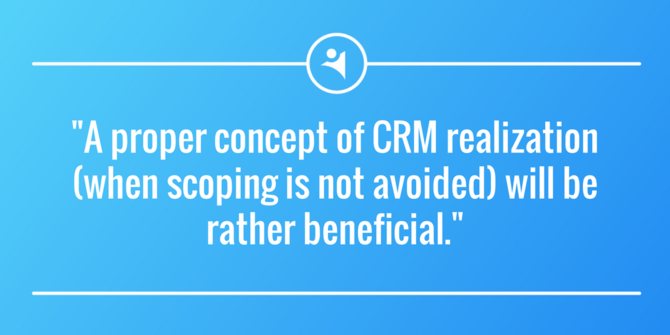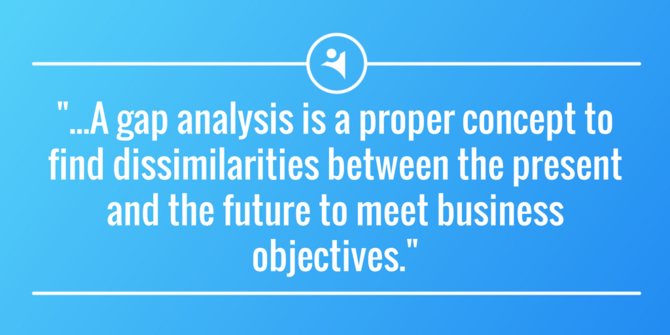2. Benefits of CRM scoping

Certainly, the said procedure is only a recommendation and everybody is free to abandon it. However, ignoring the scope of customer relationship management may lead to unfavorable outcomes including the incompatibility with the entrepreneurship, breach of trust in case of a plurilateral project, and the project failure. Meanwhile, a proper concept of CRM realization (when scoping is not avoided) will be rather beneficial.
First of all, the achievement of project outcomes will require less time. Along with that, the project execution stage will be characterized with a high performance in terms of monitoring and control. Saving time means saving efforts that, in turn, entails a financial avail by reducing overall expenses. Versatile risks and issues are also subject to reduction due to a complete definition of the project from the onset. And the final but most vital benefit foresees a high level of motivation and performance of personnel. All duties and roles will be defined and clarified for the optimum efficiency.
3. Importance of defining the scope of CRM
Though the mentioned benefits may indicate the importance of project scope for CRM once again defined by Career Trend, there are other valuable aspects answering the question “Why is it necessary?” Moreover, they define what is or is not going to happen, as well as measure future success.
Business Operations in Focus
The absence of user buy-in is the evidence of the wrong direction. In most cases, the project can be deemed failed. Such an outcome can be avoided if all relevant business operations covered by a new CRM project are understood, cleared, and defined. On this account, scoping is the initial stage of streamlining the CRM system. The emphasis is made on the current business operation and how the innovation aids to accomplish them. Interrelation with other structural units is also highlighted.
Project Definition
Obviously, defining a CRM project is a complex procedure comprising a cooperation of various key representatives of a customer and a contractor. As a rule, a special team or group is created to lay down the purpose and scope. In most cases, a document specifying terms of reference is the end product of such cooperation. All possible analytical facts, expenses, risks, requirements, etc, are established to provide a clear vision of the goal. CRM project scope is responsible for the said procedure by evaluating the existing operations and looking at them in a modernized form in the future.
Software
Certain software products won’t fit large companies with extended demands. It means that understanding what software is suitable is as essential as defining businesses tasks. For example, your labor force is limited to 50 persons and the chosen CRM system is designed for large corporations by offering multiple functions. You will hardly need the product, as you won't be even using half of it. Therefore, your demands should be equal or a bit lower than the functionality offered by the tool. Scoping is the way to eliminate such discrepancies and select a real fit for your requirements.
Non-Committal Nature
Project scoping does not commit you or your business to any obligations or actions. This procedure may be accomplished through own employees, third-parties represented by CRM partners or consultants, etc. It is even possible that you will postpone the actualization of the technology for some time in case of certain circumstances. Nevertheless, one can’t say that scope of CRM project is the waste of time. A plenty of useful data is obtained during the analysis to form a solid foundation for future endeavors. A possible scenario foresees a mismatch of your CRM cooperation partner to discovered demands and a shift to another option available on the market.
It is most likely that the mentioned benefits and important aspect of scoping your future CRM project will act as a key factor in making a decision. Still, it is not only significant to know why you need this procedure but also how to accomplish it.

4. How to define CRM scope
From theory to practice. A lot of talks about the necessity to define the scope CRM was given above. Now, it is time to describe a small guide for action.
Step One – Identification
So, take a pencil and a notepad to write down a list of relevant questions to answer. They deal with the current state of affairs of the business, possible problems, objectives, functional areas etc.
- What is the purpose of the CRM project?
- What improvements are you expecting?
- What issues will be resolved?
- Which data will be analyzed?
- What is the budget for the project?
- Who will be the users and what impact will they experience?
- What is the expected impact on clients?
- What is the calculated ROI?
- What transactions will be covered by the CRM system?
- What resources are required for streamlining?
- Which data will be used by CRM?
The list may be extended to provide a clearer understanding of what is required and where to move. It is important to give full-fledged answers since each answer can entail additional questions that are better to resolve from the onset.
Step Two – Analyzing
During the stage, the primary task stipulates gathering information about the current situation of the business and existing defects. Otherwise speaking, a gap analysis is a proper concept to find dissimilarities between the present and the future to meet business objectives.
Structural units of the enterprise, as well as key employees, should participate in such assessment. It should look like as follows:
First, you need to provide a description of technical capabilities and performance of systems and/or transactions exploited to manage the business as of today. The metrics have to be quantifiable to provide the capability to measure progress.
Second, the future state of affairs with the implemented CRM tool should be described. Once again, it is important to highlight the previously identified metrics. E.g., the interoperability among departments is increased by 30 percent.
Having compared the present state with the desired one, you are able to identify gaps and shape measures to make a shift. As a rule, the end of this step is associated with a finalized business requirements specification that contains answers to all questions above. Still, do not hurry to put into action. It is recommended to share this specification with all parties involved (structural units, partners, executives etc.) with a view to brush up final reviews and obtain feedback.
5. Conclusion
Becoming better always requires a substantial approach to changes. The essence of most things in the life stipulates a gradual progress with the subsequent evolution. The same thing is observed with defining CRM scope. It is vital for any commercial activity aimed at streamlining the said innovative technology within the business workflow. Moreover, a full-fledged approach to optimization allows revealing current flaws that may or can be obstructive for the future development. All you need is a fundamental solution and a little patience.












